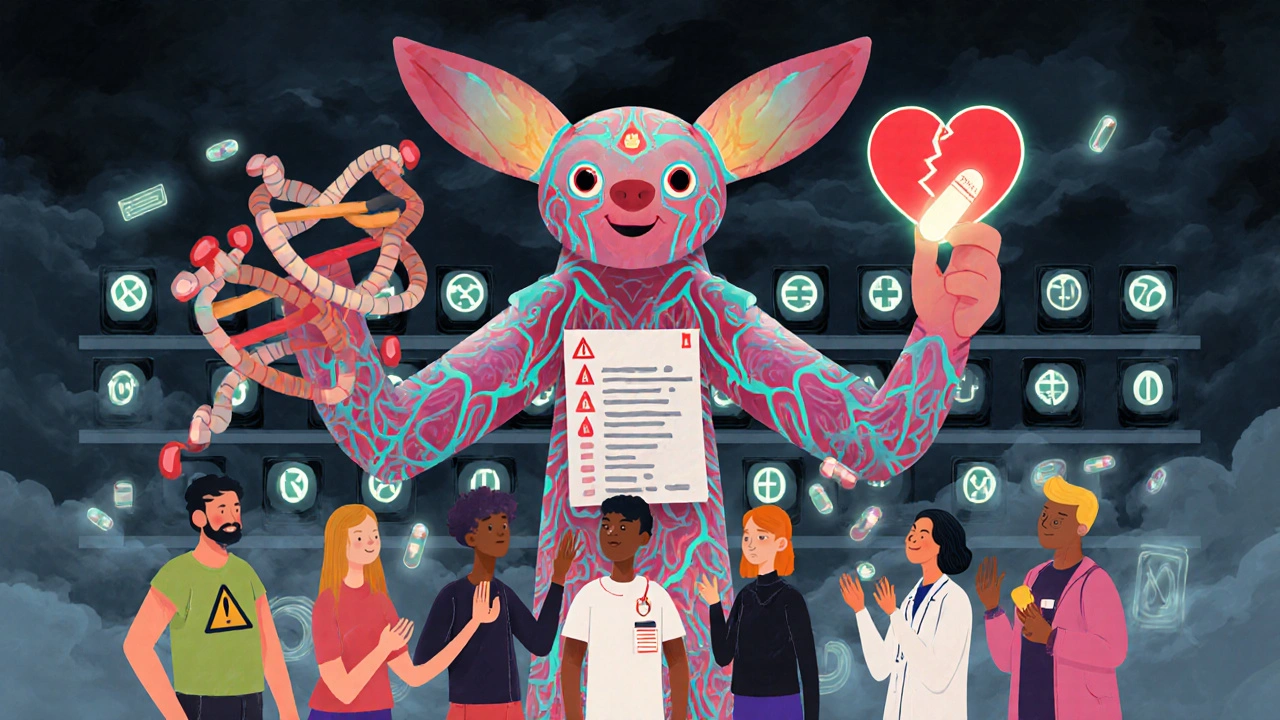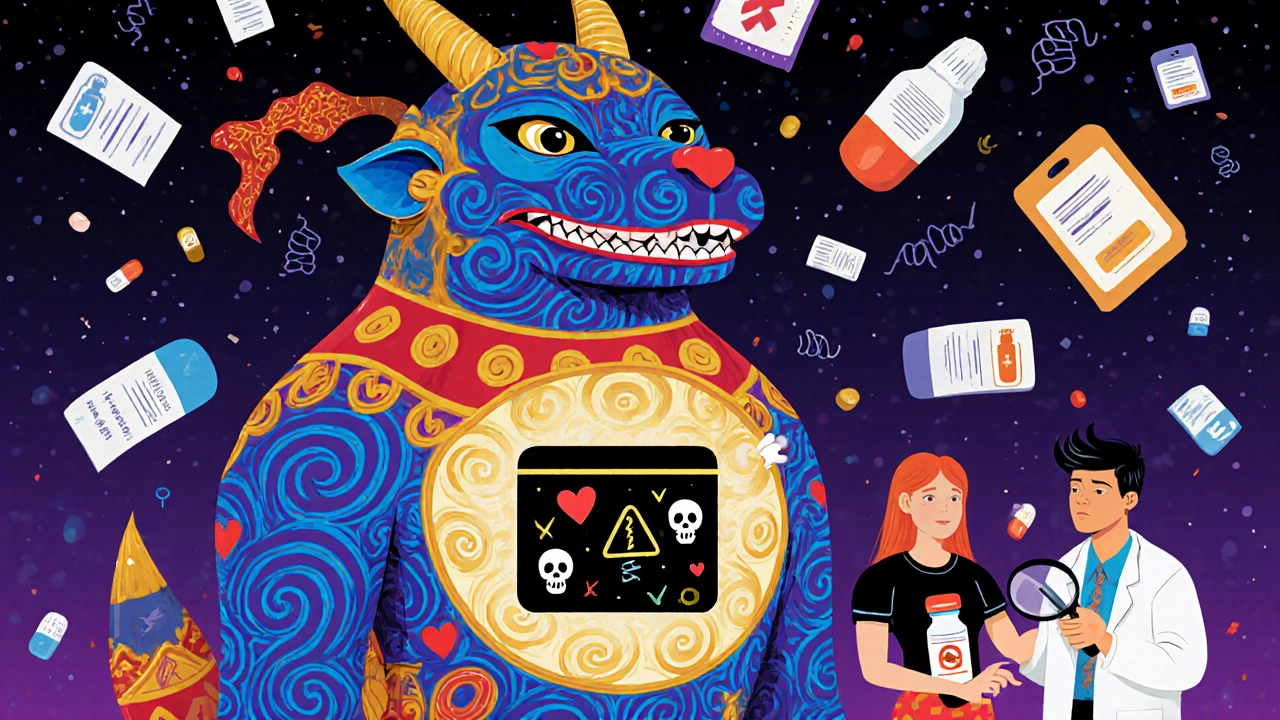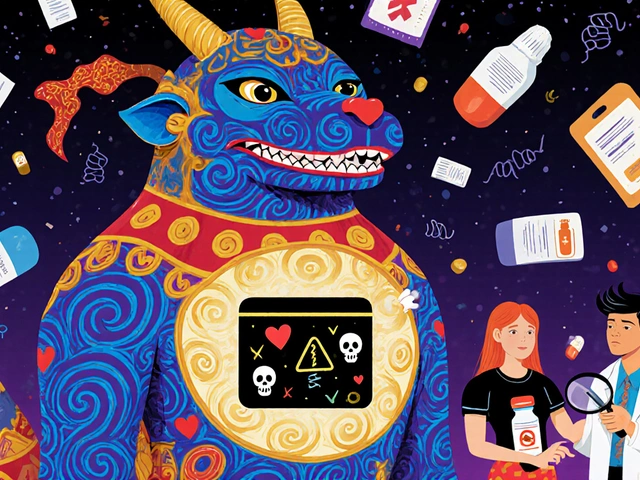Black Box Warning Checker
Check if Your Medication Has a Black Box Warning
Enter a drug name to see if it carries the FDA's highest safety alert.
When you pick up a prescription, you might not notice the thick black border around a paragraph on the drug label. But that box? It’s the FDA’s loudest alarm bell. A black box warning is the highest level of safety alert the U.S. Food and Drug Administration can issue for a medication. It doesn’t mean the drug is unsafe for everyone. It means the risks are serious enough - potentially life-threatening - that your doctor must pause, think, and talk to you before prescribing it.
What Exactly Is a Black Box Warning?
A black box warning, officially called a boxed warning, is a special section in the prescribing information for a drug. It’s surrounded by a thick black border, making it impossible to miss. This isn’t just a footnote or a small note at the bottom of a page. It’s placed right after the highlights of prescribing information, right where doctors and pharmacists look first.
The FDA requires these warnings when a drug carries risks that could lead to death or serious injury. These aren’t mild side effects like headaches or nausea. These are things like liver failure, heart attacks, suicidal thoughts, severe allergic reactions, or birth defects. The warning doesn’t just say “this might happen.” It says, “this has happened - and it was bad enough to demand your full attention.”
As of 2022, more than 400 prescription drugs in the U.S. carry a black box warning. That includes medications for depression, diabetes, arthritis, cancer, and even some antibiotics. The warning doesn’t mean the drug is banned. It means it’s powerful - and dangerous if used carelessly.
How Does the FDA Decide to Add a Black Box Warning?
The FDA doesn’t slap these warnings on drugs right out of the gate. Most black box warnings come after a drug is already on the market. That’s because some risks only show up when thousands or millions of people use the drug over time.
The agency tracks side effects through the FDA Adverse Event Reporting System (FAERS). Doctors, patients, and drug companies report problems. When a pattern emerges - say, five people on the same drug develop sudden liver failure, or young adults on an antidepressant start attempting suicide at higher rates - the FDA investigates. If the evidence is strong enough, they require the manufacturer to add the black box warning.
There are three main reasons the FDA issues one:
- The risk is so severe it could outweigh the benefits for some patients - like a diabetes drug that increases heart attack risk.
- The harm can be avoided with careful use - like needing regular blood tests to check for organ damage while on the drug.
- The drug should never be used by certain groups - like pregnant women, children, or people with a specific genetic trait.
For example, the antidepressant fluoxetine (Prozac) carries a black box warning about increased suicidal thoughts in children and teens under 25. That warning came after clinical trials showed a clear spike in suicidal behavior in young patients during the first few weeks of treatment.
What Kind of Risks Trigger a Black Box Warning?
Not all warnings are the same. The black box warning can cover several types of serious dangers:
- Death or organ failure: Drugs like clozapine (for schizophrenia) can cause a rare but deadly drop in white blood cells. Patients need weekly blood tests.
- Severe allergic reactions: Abacavir (used for HIV) can cause a life-threatening allergic reaction in people with a specific gene (HLA-B*5701). Testing for this gene before prescribing is now standard.
- Birth defects: Isotretinoin (Accutane) for severe acne can cause serious birth defects. Women must use two forms of birth control and sign paperwork before getting it.
- Psychiatric risks: Antidepressants, stimulants, and even some painkillers carry warnings about increased risk of suicidal behavior or aggression.
- Drug interactions: Some drugs, like certain antibiotics or cholesterol medications, can cause fatal heart rhythm problems when mixed with other common drugs.
One of the most famous cases is rosiglitazone (Avandia), a diabetes drug. After studies linked it to heart attacks, the FDA added a black box warning in 2007. Prescriptions dropped by 70% - but even then, millions kept taking it because doctors felt the benefits still outweighed the risks for some patients.

Does a Black Box Warning Mean You Can’t Take the Drug?
No. This is the biggest misunderstanding. A black box warning doesn’t mean “don’t take this.” It means “take this only if you understand the risks - and only if no safer option exists.”
Many life-saving drugs carry black box warnings. Chemotherapy drugs. Immunosuppressants after organ transplants. Some epilepsy medications. These drugs can kill you - but without them, you could die faster from your disease.
Doctors use what’s called the STEPS approach to decide:
- Safety: What are the risks?
- Tolerability: Can you handle the side effects?
- Effectiveness: Does it actually work for your condition?
- Price: Is it affordable? Are there cheaper alternatives?
- Simplicity: How hard is it to take correctly?
If you have a rare autoimmune disease and the only drug that works has a black box warning, your doctor might still prescribe it - because not taking it could be worse.
What Should You Do If Your Drug Has a Black Box Warning?
If you’re prescribed a medication with a black box warning, here’s what to do:
- Ask your doctor to explain the warning in plain language. Don’t just nod along. Ask: “What’s the worst thing that could happen? How likely is it? What signs should I watch for?”
- Ask about alternatives. Is there another drug without this warning? What are the trade-offs?
- Find out if you need monitoring. Will you need blood tests? Heart scans? Regular check-ins? Schedule them. Don’t skip them.
- Check for drug interactions. Tell your doctor and pharmacist every other medication, supplement, or herb you take. Some black box warnings are triggered only when mixed with other drugs.
- Report side effects. If you feel something strange - dizziness, chest pain, unusual bruising, mood changes - tell your doctor immediately. You can also report it to the FDA through MedWatch. Patients file about 200,000 reports a year.
Don’t stop the drug on your own. Stopping suddenly can be dangerous. Talk to your doctor first.

How Are Black Box Warnings Changing?
The FDA is getting smarter about how it uses these warnings. In 2021, they updated labeling rules to make black box warnings even more visible. Now, they’re placed right after the most important prescribing info - not buried in the middle of a 20-page document.
The agency is also using electronic health records and insurance data through its Sentinel Initiative to spot problems faster. Instead of waiting for thousands of reports, they can now scan data from over 300 million Americans in near real-time.
Future warnings may be more personal. Instead of saying “this drug can cause liver damage,” future labels might say: “This drug can cause liver damage in people with the CYP2D6*4 gene variant.” That’s pharmacogenomics - using your DNA to predict your risk. The FDA plans to roll this out in the next few years.
Drug companies are also starting to test for black box risks earlier in clinical trials. They don’t want to find out a drug kills people after it’s already on the market.
Why This Matters for You
Black box warnings exist because people have died - and the FDA didn’t want it to happen again. They’re not meant to scare you. They’re meant to make sure you and your doctor make a smart, informed choice.
Every year, millions of Americans take drugs with black box warnings. Some benefit greatly. Others face serious harm. The difference often comes down to one thing: communication.
If you’re on one of these drugs, don’t assume your doctor already explained everything. Don’t assume your pharmacist knows your full medical history. Ask questions. Write them down. Bring a friend to your appointment. Your life might depend on it.
And if you’re not on one yet - know this: you might be soon. With over 400 medications carrying these warnings, it’s not rare. It’s normal. Understanding what they mean is part of being an informed patient in today’s healthcare system.
Does a black box warning mean a drug is dangerous and should be avoided?
No. A black box warning doesn’t mean the drug is unsafe for everyone. It means the risks are serious enough that your doctor must carefully weigh the benefits against the dangers. Many life-saving medications - like chemotherapy drugs or immunosuppressants - carry black box warnings. The warning ensures you’re fully informed before starting treatment.
How do I know if my medication has a black box warning?
Check the drug’s prescribing information, which your pharmacist can provide. You can also look up the drug on the FDA’s Drugs@FDA website or use reliable sources like MedlinePlus. The warning will be clearly marked with a thick black border on the label. If you’re unsure, ask your doctor or pharmacist directly.
Can I still take a drug with a black box warning if I’m pregnant?
Some drugs with black box warnings are absolutely off-limits during pregnancy - like isotretinoin (Accutane), which causes severe birth defects. Others may be used only if the benefit clearly outweighs the risk. Always tell your doctor if you’re pregnant or planning to become pregnant. Never take a black box warning drug during pregnancy without explicit medical advice.
Do black box warnings apply to over-the-counter (OTC) drugs?
No. Black box warnings are only required for prescription medications. OTC drugs have different labeling rules, and while they can carry serious risks (like liver damage from acetaminophen), they don’t use the black box format. The FDA reserves black box warnings for drugs that require a doctor’s oversight due to their complexity and danger.
How long do black box warnings last?
They stay until the FDA determines the risk has changed. That could take years. Sometimes, new studies show the risk is lower than thought - and the warning is removed. Other times, more data shows the risk is even worse - and the warning is strengthened. The FDA reviews evidence continuously, especially through post-marketing surveillance programs like FAERS and Sentinel.

